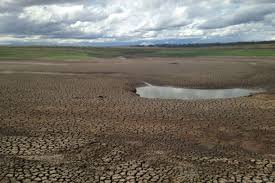‘River debt’ means Barwon-Darling recovery likely to lag rain’s return

The recovery in the health of major river systems such as the Barwon-Darling is likely to be delayed well after the return of good rainfall because of policy changes under which irrigators will get the first right to any flows, a new paper says.
The Australia Institute report found that cotton growers in the northern Murray-Darling Basin used about 2000 billion litres last year, or almost 200 times the flow that reached Wilcannia on the Darling River in far-west NSW.
However, because of changes to the catchment’s water-sharing plans in 2011 – when irrigators were previously deemed to have over-extracted from the river – the farmers were then “owed” 635 billion litres. That total is “almost enough for this year’s cotton crop”, it said.
“Alas, the Barwon-Darling or Barka [as the river is known to the Indigenous population] does not have the water to pay back these ‘debts’,” the report said, noting that in years where this water cannot be delivered, the debt is simply ‘carried over’ to the next year.
“Irrigators can take 300 per cent of their allocation when water is available to make up for past years’ water absence,” it said.
Maryanne Slattery, a senior water researcher at The Australia Institute and a former Murray-Darling Basin Authority staffer, said the river was unlikely ever to repay this debt “because of climate change, increased extractions and the allocation policies upstream”.
“[The] NSW and federal governments and agencies knew that too much water was being diverted from the Barwon-Darling/Barka,” she said. “Rather than enforcing limits, they changed their computer models to show that water diversions were within the existing policy.”
‘Must be protected’
A spokeswoman from the office of Minister for Regional Water Niall Blair rejected the report’s accounting approach, and said actual credits would be different.
“On the first of July 2019, cap credits across the Murray Darling Basin, including the Barwon-Darling will be removed when the Sustainable Diversion Limit framework is commenced,” she said.
“The department is finalising the Barwon-Darling Water Sharing Plan in consultation with stakeholders,” she said, adding that the rule would limit what could be extracted in a year, and there were other levels below which water could not be extracted.
Chris Minns, NSW Labor’s water spokesman, said the first significant rainfall that hits the catchment “must be protected by the NSW government”.
“Protecting towns’ and cities’ water supplies must be the first priority of any political party, particularly with many towns having run out of water,” he said.
‘Kicking an industry’
“Kicking an industry that is significantly impacted by the drought for political advantage is not only shameful, but detrimental to our regional communities and economies,” Mr Murray said.
He said that – as noted in the report – Australia’s cotton crop had been cut in this year as the drought hit.
“The crop being grown at the moment is using water carried over from floods in 2016, bore water or dry land (non-irrigated) [cotton],” Mr Murray said.
“Cotton is one of the most profitable crops in Australia and the flow-on effects ensure more than 150 regional communities continue to survive, even through the tougher drought years.”
Originally published by The Sydney Morning Herald, 15 March 2019.
